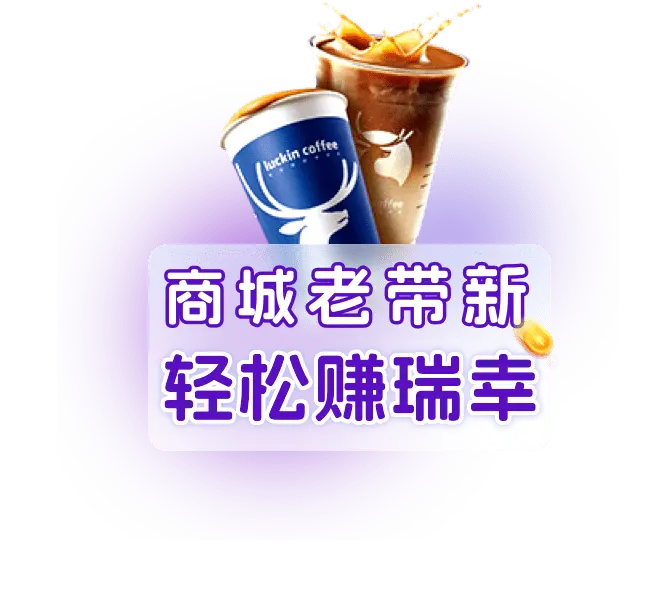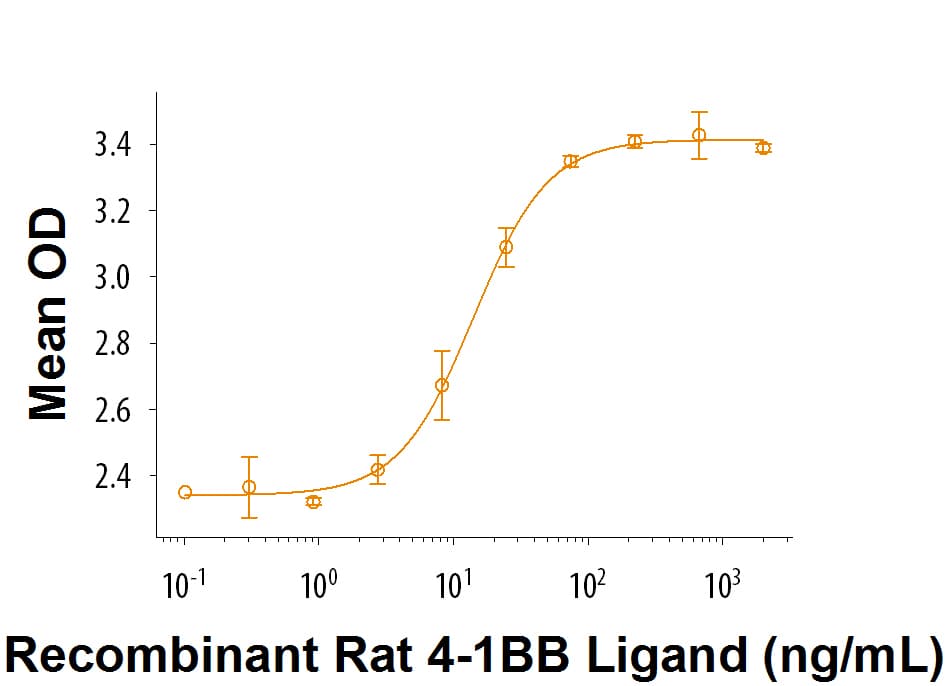 全部商品分类
全部商品分类



 下载产品说明书
下载产品说明书 下载SDS
下载SDS 用小程序,查商品更便捷
用小程序,查商品更便捷


 收藏
收藏
 对比
对比 咨询
咨询Scientific Data
 View Larger
View LargerWhen Recombinant Rat 4-1BB/TNFRSF9 Fc Chimera (Catalog # 7968-4B) is coated at 100 ng/mL, Recombinant Rat 4-1BB Ligand/TNFSF9 (Catalog # 9188-4L) binds with a ED50 of 1-6 ng/mL.
 View Larger
View LargerRecombinant Rat 4-1BB Ligand (Catalog # 9188-4L) co-stimulates IL-2 secretion by mouse T cells in the presence of anti-CD3. The ED50 for this effect is 5-30 ng/mL.
Carrier Free
CF stands for Carrier Free (CF). We typically add Bovine Serum Albumin (BSA) as a carrier protein to our recombinant proteins. Adding a carrier protein enhances protein stability, increases shelf-life, and allows the recombinant protein to be stored at a more dilute concentration. The carrier free version does not contain BSA.
In general, we advise purchasing the recombinant protein with BSA for use in cell or tissue culture, or as an ELISA standard. In contrast, the carrier free protein is recommended for applications, in which the presence of BSA could interfere.
9188-4L
| Formulation | Lyophilized from a 0.2 μm filtered solution in PBS with BSA as a carrier protein. |
| Reconstitution | Reconstitute at 250 μg/mL in PBS. |
| Shipping | The product is shipped at ambient temperature. Upon receipt, store it immediately at the temperature recommended below. |
| Stability & Storage: | Use a manual defrost freezer and avoid repeated freeze-thaw cycles.
|
9188-4L/CF
| Formulation | Lyophilized from a 0.2 μm filtered solution in PBS with Trehalose. |
| Reconstitution | Reconstitute at 250 μg/mL in PBS. |
| Shipping | The product is shipped at ambient temperature. Upon receipt, store it immediately at the temperature recommended below. |
| Stability & Storage: | Use a manual defrost freezer and avoid repeated freeze-thaw cycles.
|
Recombinant Rat 4-1BB Ligand/TNFSF9 Protein Summary
Product Specifications
Arg103-Gly308, with an N-terminal 6-His tag
Analysis
Background: 4-1BB Ligand/TNFSF9
4-1BB Ligand (4-1BBL), also known as CD137L, is a type II transmembrane protein that belongs to the TNF superfamily of molecules and plays an important role in immune response activation (1). The approximately 50 kDa rat 4-1BB Ligand consists of an 82 aa cytoplasmic domain, a 21 aa transmembrane segment, and a 206 aa extracellular domain (ECD) (2). Within the ECD, rat 4-1BB Ligand shares 34% and 86% aa sequence identity with human and mouse 4-1BB Ligand, respectively. 4-1BB Ligand is expressed by activated B cells, monocytes, macrophages, dendritic cells (DC), T cells, lymphoma and multiple myeloma cells, hematopoietic stem cells, early myeloid progenitors, neurons, and astrocytes (3-9). A 26 kDa soluble form of 4-1BB Ligand can be released from the surface of activated cells and retains bioactivity (10). 4-1BB Ligand binds to 4-1BB/TNFRSF9/CD137 on activated CD4+ and CD8+ T cells, thymocytes, and NK cells as well as on monocytes, neutrophils, DC, and eosinophils. In response to 4-1BB Ligand binding, 4-1BB transduces a co-stimulatory signal that promotes the proliferation, activation, and survival of CD4+ and CD8+ T cells (4, 11, 12). T cell co-stimulation through CD28 is important for the initial T cell expansion, while 4-1BB acts later in the response (12, 13). 4-1BB Ligand function supports the survival and responsiveness of memory T cells during viral infection (13-15). Reverse signaling through
4-1BB Ligand on monocytes induces the production of inflammatory cytokines (5). On macrophages, 4-1BB Ligand associates in cis with TLR4 and enhances inflammatory cytokine production in response to TLR4 ligation (6). Its expression on early myeloid progenitor cells limits the development of dendritic cells, monocytes, and B cells (9).
- Wang, C. et al. (2009) Immunol. Rev. 229:192.
- Dong, Q.M. et al. (2005) Acta Biochim. Biophys. Sin. 37:694.
- Reali, C. et al. (2003) J. Neurosci. Res. 74:67.
- DeBenedette, M.A. et al. (1997) J. Immunol. 158:551.
- Langstein, J. et al. (1998) J. Immunol. 160:2488.
- Kang, Y.J. et al. (2007) Nat. Immunol. 8:601.
- Baessler, T. et al. (2010) Blood 115:3058.
- Gullo, C. et al. (2010) PLoS One 5:e10845.
- Lee, S.-W. et al. (2008) Nat. Immunol. 9:917.
- Salih, H.R. et al. (2001) J. Immunol. 167:4059.
- Wen, T. et al. (2002) J. Immunol. 168:4897.
- Cannons, J.L. et al. (2001) J. Immunol. 167:1313.
- Bertram, E.M. et al. (2002) J. Immunol. 168:3777.
- Bukczynski, J. et al. (2004) Proc. Natl. Acad. Sci. USA 101:1291.
- Lin, G.H.Y. et al. (2009) J. Immunol. 182:934.


参考图片
When Recombinant Rat
4-1BB/TNFRSF9 Fc Chimera (Catalog # 7968-4B) is coated at 100 ng/mL, Recombinant Rat 4-1BB Ligand/TNFSF9 (Catalog # 9188-4L) binds with a ED50 of 1-6 ng/mL.
Recombinant Rat 4-1BB Ligand (Catalog #
9188-4L) co-stimulates
IL-2 secretion by mouse T cells in the presence of anti-CD3. The ED50 for this effect is 5-30 ng/mL.




